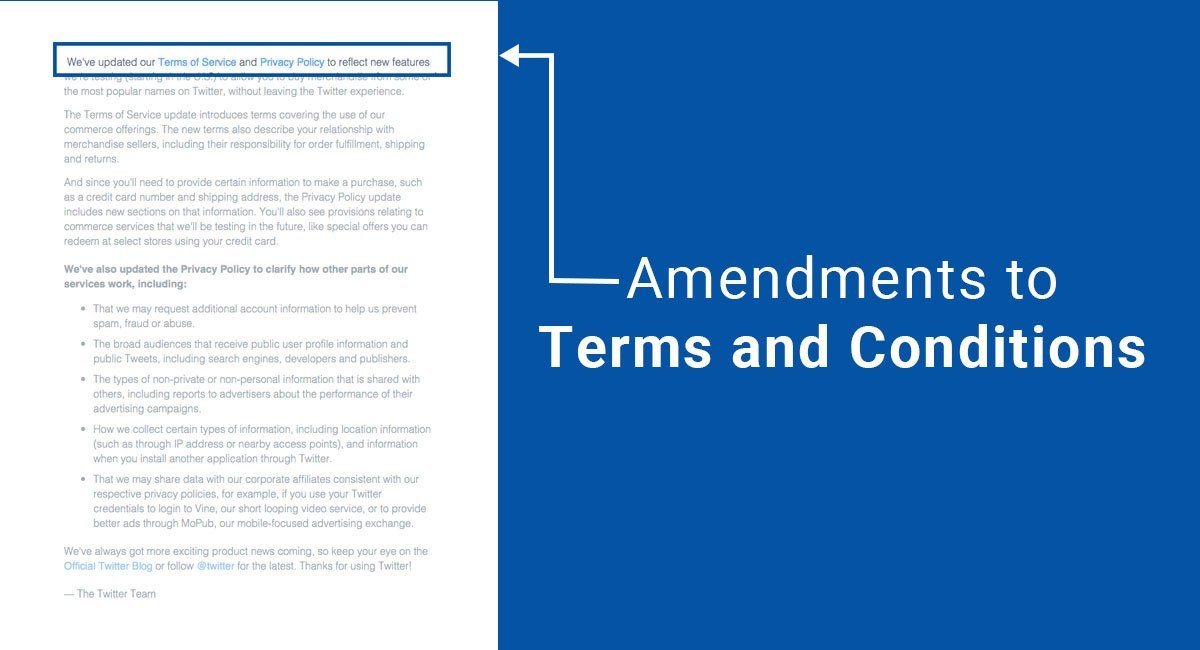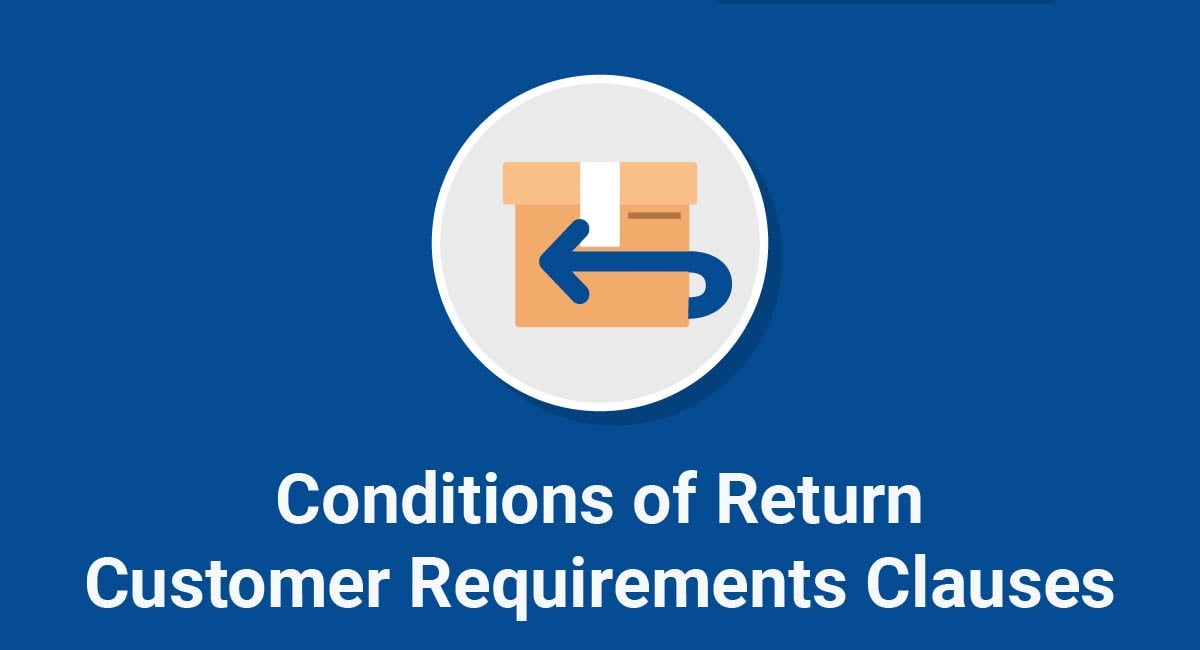Arbitration clauses are commonly used in general consumer contracts, but also in Terms and Conditions agreements (also known as Terms of Use or Terms of Service) for websites and mobile apps.
Simply put, the arbitration clause requires that the two parties to an agreement will go through arbitration rather than either party initiating a lawsuit if a dispute arises.
Arbitration is a process that involves both parties meeting with a qualified arbitrator who functions similarly to a judge in a courtroom by deciding which party's argument and the case has more merit and should prevail. This process can be either binding or non-binding, depending on the language of the agreement.
Binding arbitration means that whatever decision the arbitrator makes is considered final.
Non-binding arbitration allows either party to take the case to an actual courtroom if the outcome is unsatisfactory to the parties involved.
Businesses generally include this type of clause in contracts when they don't want to open themselves up to time-consuming and drawn out lawsuits in the event of a dispute with a customer or client. If you wish to keep more control over how disputes are handled, consider including this clause in your Terms and Conditions. Weigh the advantages and disadvantages for both you and your customers before including this clause.
Our Terms and Conditions Generator makes it easy to create a Terms and Conditions agreement for your business. Just follow these steps:
-
At Step 1, select the Website option or the App option or both.

-
Answer some questions about your website or app.
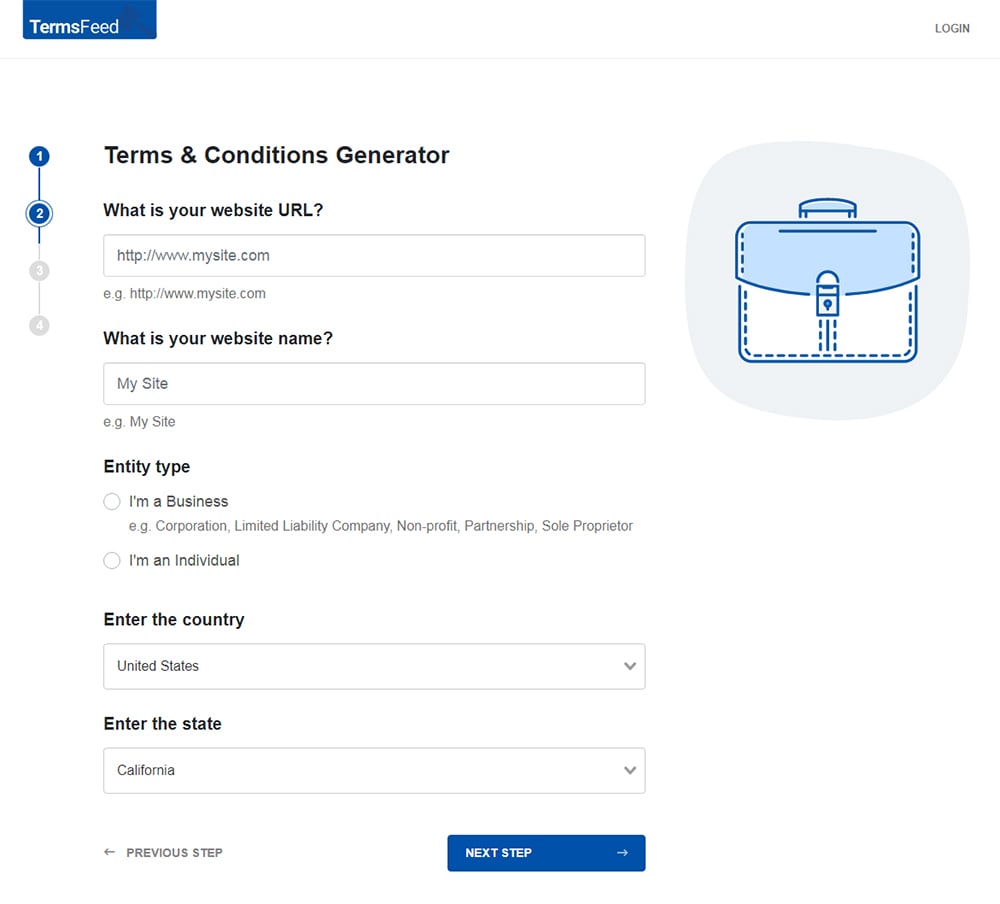
-
Answer some questions about your business.

-
Enter the email address where you'd like the T&C delivered and click "Generate."

You'll be able to instantly access and download the Terms & Conditions agreement.
Advantages and disadvantages
Advantages
Why do businesses choose arbitration over conventional litigation? There are a number of advantages.
Faster Resolution
The main advantage is that it is much faster than litigation.
Scheduling an immediate session with an arbitrator is much easier than getting an early hearing date set. Rescheduling is also easier done with an arbitrator than with courts.
Specialized Decisions
If your case involves a technical concept or a specialized industry, such as patents or engineering issues, arbitration allows you to choose an arbitrator with specialized knowledge of that concept or industry.
This can be advantageous for parties rather than dealing with a judge who potentially has no knowledge or experience with that industry.
Disadvantages
Arbitration does have some key disadvantages that you should know about before utilizing it.
No Appeals
Unlike a typical court trial, appeals are not allowed in arbitration cases unless it is proven that the arbitrator was biased or that his or her opinion violated public policy.
This finality can be unattractive to some who want to keep options open and have the ability to appeal a decision.
Very Costly
Arbitration tends to be far more financially costly than litigation.
An arbitrator is paid privately by the parties involved (you as a business and the user), and this cost can easily be in the thousands of dollars.
You are paying for convenience, flexibility in scheduling, and getting to choose traits of your arbitrator rather than getting a random judge.
You Lose Your Right to Sue
If you're a disgruntled customer or client to a business that has an arbitration clause in their Terms and Conditions and you agree to this agreement, you can no longer sue or join a class action lawsuit against the business.
As a user who agreed to this agreement, you are forced to take all legal recourse issues through an arbitration hearing. This loss of freedom of choice can be frustrating for individuals who wish to sue rather than arbitrate.
According to this article about Slack.com's own clause, forced or mandatory arbitration takes away the right of wronged consumers to band together and form a convenient class action lawsuit.
By forcing each individual to go through an arbitration hearing, pressure is taken off of the business and is placed onto the consumer.
However, arbitration isn't perfect.
-
It's expensive.
Litigation is expensive, but arbitration is even more costly since you'll be paying for things like convenience and flexibility in scheduling, as well as the specialized knowledge of the industry of the arbitrator.
-
It can be final.
Binding arbitration decisions don't come with appeals unless you can prove that the arbitrator was biased, or was violating public policy with his decision.
This means you'll be giving up your right to appeal a decision if you lose.
However, non-binding arbitration isn't favored by businesses because it allows the losing party to take the case to an actual courtroom if it wishes.
You can see why a business wouldn't want to include an arbitration clause that would just allow a customer to basically circumvent the arbitration and go to regular litigation if he loses in arbitration.
After weighing the pros and cons of arbitration, it's clear that most businesses choose to include an arbitration clause in their legal agreements that will require arbitration - binding arbitration - in the event of a dispute.
Examples of Arbitration clauses
![]()
Here's an example of a standard arbitration clause, in use at Amazon.com.
Within Amazon's Conditions of Use agreement, you can find a section titled Disputes. The very first sentence of this section states clearly:
any dispute or claim relating in any way to your use of any Amazon Service, or to any products or services sold or distributed by Amazon or through Amazon.com will be resolved by binding arbitration, rather than in court.
This section is in bold font and gets right to the point. This section also:
- Informs users of their right to assert a claim in a small claims court under certain circumstances,
- Describes generally what arbitration is and how the scope of arbitration will be limited, and
- Lets a user know how to begin an arbitration proceeding.
Here's how it looks:

This can be a very good format for an arbitration clause in your Terms and Conditions agreement.
Users are not only informed of their rights but get a little knowledge about arbitration as well as practical information about what to do to start a proceeding in the event it's needed.

Here's how Slack mentions their arbitration inside their Terms of Service agreement:
PLEASE READ THIS SECTION CAREFULLY! IT MAY SIGNIFICANTLY AFFECT YOUR LEGAL RIGHTS, INCLUDING YOUR RIGHT TO FILE A LAWSUIT IN COURT AND TO HAVE A JURY HEAR YOUR CLAIMS. In order to expedite and control the cost of disputes, you and we agree that any legal or equitable claim arising out of or relating in any way to your use of the Services or this TOS, and the formation, validity, enforceability, scope, or applicability of this TOS, including this Section 10 (referred to as a "Claim") will be resolved as follows:
References to this clause is mentioned at the top of their page to make sure users are aware of the arbitration clause:

Dropbox also informs users that arbitration is used in their Terms of Service:
IF YOU'RE A U.S. RESIDENT, YOU ALSO AGREE TO THE FOLLOWING MANDATORY ARBITRATION PROVISIONS:
We Both Agree To Arbitrate. You and Dropbox agree to resolve any claims relating to these Terms or the Services through final and binding arbitration, except as setting forth under Exceptions to Agreement to Arbitrate below.
BuzzFeed also includes arbitration in its User Agreement:
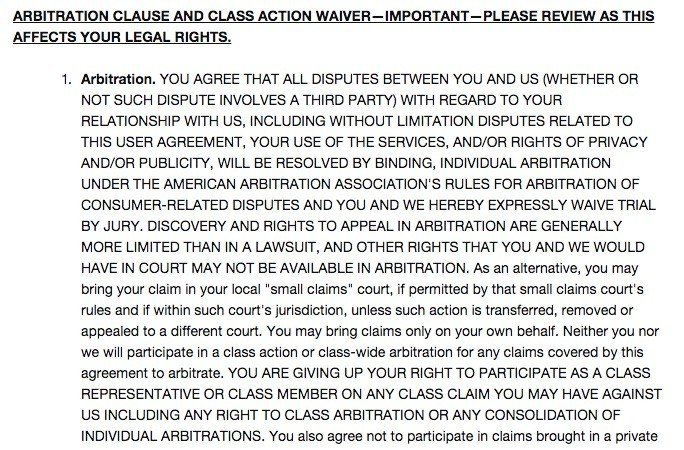
How to inform users of arbitration clauses
The clause language itself is important, but how you inform users that such a clause exists is crucially important as well.
Earlier this year, a California court overseeing the Long v. Provide Commerce, Inc. case held that a user wasn't bound to an arbitration clause in the Terms of Use of ProFlowers because there was not enough notice given to the user that the clause existed and that he would be bound to it by making a purchase on the website.
In other words, simply putting a link to your Terms of Service on the footer of your website and then including an arbitration clause within the terms like the one shown above can potentially be considered not enough to bind a consumer to the arbitration clause.
The court made a suggestion that businesses go one step further by including a "conspicuous textual notice" that informs users that the "linked page contains binding contractual terms."
Since this ruling, ProFlowers - an FTD Company - has added a new first sentence to its Terms and Conditions agreement. This sentence in the company's agreement reads:
These terms and conditions contain a binding arbitration clause and class action waiver that impact your rights about how to resolve disputes. If you live in the United States, please read it carefully.
Here's how it looks:
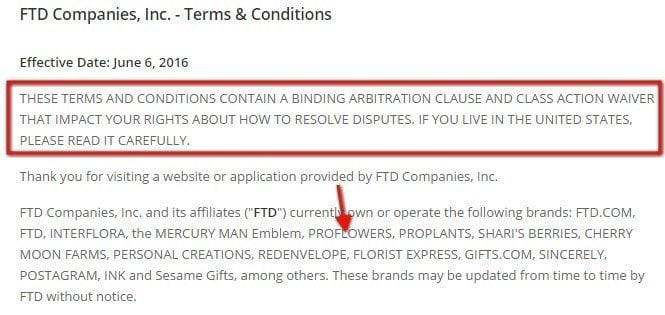

Slack has updated its Terms of Service to include a reference to its arbitration clause in the very first sentence of its agreement.
This sentence lets users know that the clause can be found in Section 10, where it may have otherwise remained buried:
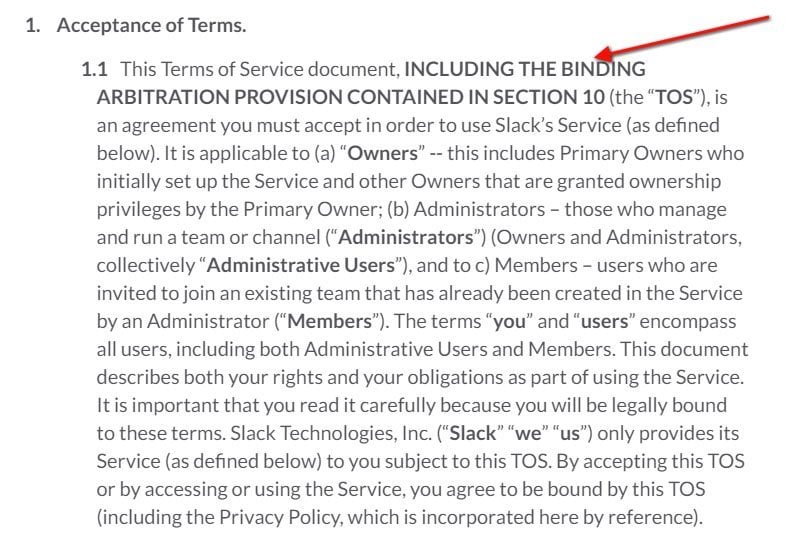

The User Agreement of eBay Introduction is three paragraphs long, with the last and longest of them being about its arbitration clause.
Here, users are made aware that the user agreement "contains an Agreement to Arbitrate, which will, with limited exception, require you to submit claims you have against us to binding and final arbitration..."
Here's how it looks:

This is a satisfactory way to let users know right away that there's an important arbitration clause within the long text of the agreement and makes it far less likely that a user will just overlook the clause or not know about it.
However, you should also consider including a way for users to opt out of your arbitration clause and including it in the arbitration clause itself.

The reason this opt-out is important can be seen in a recent court case involving Uber. In Suarez v. Uber Technologies Inc., the court upheld Uber's arbitration clause with its drivers.
An important factor as to why the clause was upheld was because Uber gave its drivers the option to opt-out of the arbitration clause if they so wished.
This meant that by not opting out within the provided 30-day time period, combined with other factors such as using the clickwrap method, the drivers should be bound by the arbitration clause.

Dropbox includes a link in the second sentence of its arbitration clause where users are able to opt out of the arbitration agreement within 30 days of first accepting the rest of the Dropbox's Terms of Service, which is where the arbitration clause can be found:

The Terms of Use of Instagram include the "Arbitration Notice" as the third paragraph of the terms. Note the bold font and capital letters, all which help to draw attention to this paragraph, as well as its placement early in the agreement:

This paragraph starts off by saying, "Except if you opt-out..." which immediately lets users know that an option to opt out is available and that by not doing so, they are essentially agreeing to the arbitration clause.
While a direct way for users to opt out isn't provided here, there are instructions in the actual arbitration clause itself further within the agreement.
Users are told that they must notify Instagram of an opt-out in writing within 30 days of becoming subject to the arbitration clause. This means a user would have 30 days from the day the user agrees to be bound by the terms, which is typically the day a user completes sign-up for an account.
Users are given an address where the opt-out can be sent, and a list of what the user must include in the written communication, including name, email address, and a clear statement showing intent to opt out of the arbitration agreement:

How to include arbitration clause in terms
If you decide to include an arbitration clause in your legal agreement, you should do the following to make sure that your clause will be enforceable:
-
Mention the clause early on.
Include notice early on in your legal agreement that there's an arbitration clause further along in the agreement, or move the entire clause towards the very beginning of your agreement.
-
Provide users with a way to opt-out.
Provide a link or clear instructions for how a user can opt out of the arbitration clause any time within the first 30 days that the clause would be in effect for that user.
-
Create a binding agreement with the clickwrap method.
Don't only include a link to your Terms and Conditions in the footer of your website and assume that it will bind users.
Make users actively click to agree to your Terms & Conditions by providing "I accept" buttons or checkboxes on pages where users are creating accounts, making purchases, or doing other activities that would make them fall under the scope of your agreement.
See the example below from Amazon AWS that provides a link to the relevant agreement and makes a user click both a checkbox, as well as a "Create Account and Continue" button for confirmation:

-
Be reasonable with your arbitrator choices.
Don't choose unnecessarily expensive arbitrators that your users won't be able to afford. This can be seen as an attempt to deter fair arbitration by courts.
Choose a reasonable association that has fair prices, rules that are easy to find and understand, and easy initiation of claims.
-
Be reasonable with your requirements.
Don't hold users to impossibly difficult standards or requirements for when they want to compel arbitration. A court may find it unconscionable and strike down your arbitration clause.

Comprehensive compliance starts with a Privacy Policy.
Comply with the law with our agreements, policies, and consent banners. Everything is included.



